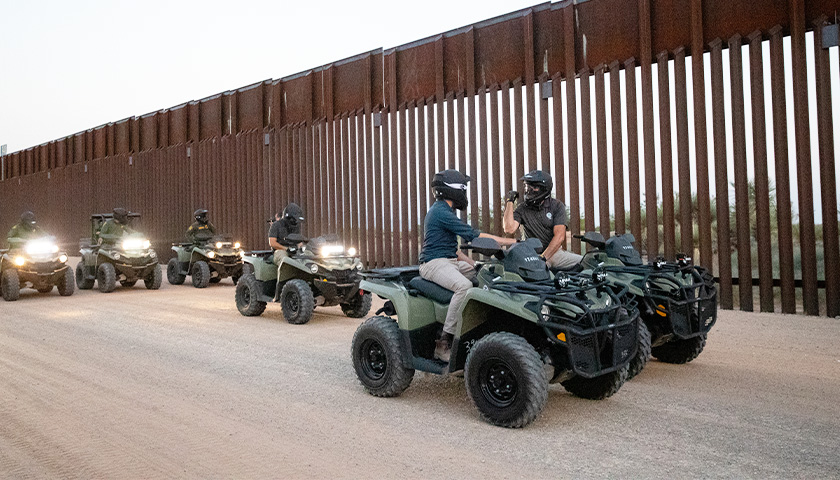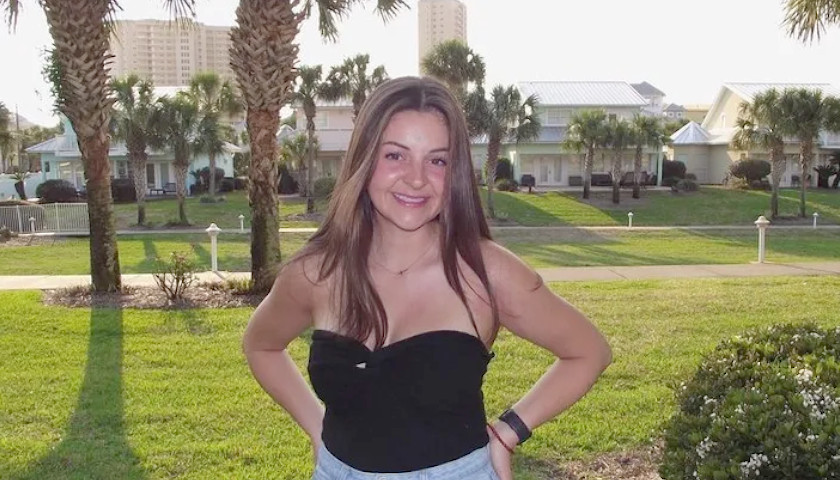by Jarrett Stepman
The 24-hour drop-off in Martha’s Vineyard of about 50 illegal immigrants was treated as a crisis by many in the media, with some comparing it to the Holocaust.
Arizona Gov. Doug Ducey and Texas Gov. Greg Abbott, both Republicans, began sending illegal immigrants to two large, northern blue cities: New York and Washington, D.C. This triggered howls of protest from those cities’ Democrat mayors.
But the migrant crisis really hit the national conversation when Florida Gov. Ron DeSantis, also a Republican, sent roughly 50 asylum-seekers to Martha’s Vineyard—a small, wealthy liberal enclave off the coast of Massachusetts. The Florida governor’s move was met with histrionic condemnation by the Left.
How could poor Martha’s Vineyard, with a population of 15,000 nowhere near the southern border, be expected to handle such an overwhelming number of migrants? This relative handful of illegal immigrants quickly was bused to a military base in Cape Cod, on the mainland, just a day after arriving.
What Martha’s Vineyard had to deal with, in terms of numbers, is nowhere near what countless communities along the southern border deal with every day.
These border towns don’t have herds of fawning, sympathetic media to bring attention to their plight or shine a light on how President Joe Biden’s administration has triggered a crisis that the towns have few tools to negate.
To highlight the scope of what’s happening on the border, here’s a profile of the crisis of illegal immigration for six cities in Texas and Arizona—mostly as small or even smaller than Martha’s Vineyard.
Uvalde, Texas
The horrific mass shooting at Robb Elementary in Uvalde, Texas, exposed some of the indirect effects of President Joe Biden’s border crisis. The city of just over 15,000 has been inundated with illegal immigrants and asylum-seekers since that crisis exploded.
The Center Square reported on the surge in April:
Uvalde Mayor Don McLaughlin said [U.S. Customs and Border Protection] agents told him to expect up to 150 people to be released daily into his community, Fox 29 News reported. A minimum of 150 people released a day, 365 days a year, translates to 54,750 people being released into a town with a population of roughly 17,000.
Just 50 illegal immigrants showing up would be a good day in Uvalde.
Most perniciously, drug smugglers and human traffickers have been a common problem for both the U.S. Border Patrol and local law enforcement in Uvalde. As I wrote in July, the issue created some of the factors that led to the lax policing at the time of the Robb Elementary shooting.
The number of times that police ended up chasing drug smugglers jumped from “averaging probably three to five chases a week” to about “two to three a day,” McLaughlin said in an April interview with National Review.
Many of these chases end up at schools, where fleeing drug smugglers often “bail out.”
A report from a Texas House special committee found that security became lax due to the frequency of such lockdowns.
“The frequency of these ‘bailout’-related alarms—around 50 of them between February and May of 2022—contributed to a diminished sense of vigilance about responding to security alerts,” the Texas House committee report states.
Del Rio, Texas
It was in Del Rio that photos of Border Patrol agents attempting to stop incoming Haitian migrants went viral. Even though they were doing their job and were cleared of the charge of “whipping” the illegal aliens, the Biden administration still threw the agents under the bus.
Del Rio has dealt with the enormous challenge not only of a general increase in illegal immigration, but, in 2021, tens of thousands of Haitian migrants showing up all at once. Many of these asylum-seekers eventually were expelled from the country, but the flood of illegal immigration remained a huge problem for the local community.
Del Rio has a population of 34,673. In January, nearly that many illegal immigrants crossed into the Del Rio sector along the border. This from a February report by the Washington Examiner:
Last month, 30,773 people were encountered illegally crossing the border in Border Patrol’s Del Rio sector, which spans 240 miles of the 2,000-mile U.S.-Mexico boundary. For each of the town of Del Rio’s 34,673 residents, one noncitizen was taken into custody.
For several years, the Del Rio sector was relatively quiet.
“In all of [fiscal year] 2017, the 1,391 agents there apprehended 13,476 illegal entrants, an average of 37 per day,” Andrew R. Arthur wrote for the Center for Immigration Studies.
After a brief but significant surge of illegal entrants in 2019, the Trump administration implemented new policies—among them “Remain in Mexico”—to get the problem under control. It worked.
However, under Biden the problem spun out of control. In fiscal year 2021, 1,500 agents in the Del Rio sector “had to apprehend, process, transport, and care for a whopping 259,000-plus migrants,” Arthur wrote, adding:
That equals out to an average of 710 migrants per day, or roughly 19 times the traffic just four years prior. In September 2021 alone, Del Rio sector agents encountered more than three times as many illegal entrants (43,570) than they had in all of FY 2017.
It became worse in fiscal 2022, which ended Friday. In the first 10 months, Arthur wrote, “agents in Del Rio sector have apprehended more than 376,000 illegal migrants—an average of 1,774 per day.”
El Paso, Texas
The West Texas city of El Paso, also located on the southwest border, has been inundated with illegal immigrants. This past year, the problem became extreme.
“Unauthorized border crossings climbed 71% in Border Patrol’s El Paso Sector in the first quarter of fiscal 2022, compared to the same three-month period a year ago,” the El Paso Times reported in January. “U.S. Customs and Border Protection reported 49,012 encounters [in] October through December in the sector that includes West Texas and New Mexico, up from 28,553 in the first quarter of fiscal 2021.”
It’s now even worse.
Since the beginning of September, over 1,000 migrants arrive every day in the city of just under 700,000.
El Paso may be larger than other border towns, but that doesn’t mean it’s able to handle the sheer quantity of people it’s been expected to process.
Border crossers typically are processed in a huge center that can accommodate 3,400, according to the New York Post. However, with the flood of additional migrants, a “makeshift set-up under the local highway overpass” now is being used, the Post reported.
“The migrants are then either ditched on local streets, since there are no more government-funded hotel or shelter rooms available, or helped along to their final destination—which is usually New York City,” the Post reported El Paso officials as saying.
Eagle Pass, Texas
The 50 asylum-seekers flown to Martha’s Vineyard by DeSantis started their journey in Eagle Pass, Texas.
While Martha’s Vineyard struggled to deal with 50 migrants, Eagle’s Pass concurrently was hit with 500 illegal immigrants crossing the border in a two-hour period, according to Fox News.
It’s an increasingly common occurrence in the besieged border town of 28,000, which is almost entirely Hispanic and where per capita income is $18,832 a year.
Fox News national correspondent Bill Melugin reported that more than 450,000 illegal crossings occurred this year in the Eagle Pass sector.
Crossing that part of the border, which requires traversing the Rio Grande, is a treacherous trek. The sheer number of illegal crossings has led to a surge of rescues and deaths in the Rio Grande.
Eagle Pass Fire Department Chief Manuel Mello III, in an interview with Fox News, said that in Maverick County—where Eagle Pass is located—authorities are on pace for 300 body recoveries this year.
“Since October, CBP [Customs and Border Protection] has conducted nearly 19,000 search and rescue efforts, compared to less than 5,000 in fiscal 2019,” Fox News reported.
The problem is so severe that morgues in Eagle Pass and other border towns are having difficulty keeping up with demand. The fire department requested refrigerators for storing drowned migrants.
“There are so many bodies being recovered that the morticians are asking for assistance,” Mello told the Daily Caller. “I had never seen so many drownings like we’re seeing right now. We do a body recovery daily. It’s very traumatic for my personnel.”
Yuma, Arizona
Texas isn’t the only state with besieged border towns. Yuma, Arizona—a city of 97,000—has been swamped with illegal immigrants.
“You have mayors from Washington, D.C., and New York City that are complaining about a couple of thousand people over three or four months—we’re seeing those numbers monthly or even weekly,” Yuma Mayor Doug Nicholls, a Republican, told reporters, according to Conn Carroll at the Washington Examiner. “If those few thousand people are having an impact, imagine the impact of over 200,000 people.”
The Washington Examiner explained the crisis faced by Yuma:
In December, Nicholls declared a state of emergency after 6,000 people were encountered coming across the border in just four days. The Border Patrol was unable to respond to the number of people crossing, prompting migrants to walk into town looking for help, Nicholls said. He left the state of emergency in place for the past five months because he has ‘not seen anything from the administration or the [homeland security] secretary that looks like it’s going to change this flow.’
It’s not just a problem with border crossers. The Border Patrol also is releasing migrants in Yuma.
Nicholls reportedly asked the Biden administration to stop this, to no avail.
When DeSantis drops off 50 migrants in Martha’s Vineyard, it’s “human trafficking,” according to left-wing activists in the media. When the Biden administration releases thousands of illegal immigrants into a small city, it’s Monday.
This situation has strained the city’s medical system to the limit. No surprise, tourism has dropped.
Yuma has an additional challenge: a gap in the border wall in the area. The state of Arizona took the initiative to put a bandage on the problem by filling the gap with large cargo containers.
According to CBS8, Arizona is spending “$6 million of [its] $335 million from the state budget to address border security issues by installing shipping containers.”
Gila Bend, Arizona
An even more extreme example of an even smaller Arizona town dealing with a gargantuan illegal immigration mess is Gila Bend.
Gila Bend has just 1,900 residents, but has been a dumping ground for illegal immigrants picked up elsewhere by the Border Patrol. The rural community is about 80 miles north of the border and essentially has no infrastructure to accommodate the waves of migrants dropped off there.
It’s hardly the kind of place that is equipped to handle more than a handful of arrivals.
“Looking at my local media in Arizona, they’re dropping them off in Gila Bend,” Douglas Mayor Donald Huish said in a 2021 interview with Newsweek. “Gila Bend is out in the middle of nowhere. I just scratched my head. What’s the philosophy of that? I know the poor mayor up there is at his wit’s end, not knowing what to do.”
It’s an extremely difficult situation to put a small town in. Of course, Gila Bend’s plight didn’t get a fraction of the national media attention that Martha’s Vineyard recently received.
“The reaction to Martha’s Vineyard suggests it is good to be a rich white person in America because you won’t have to deal such problems,” Gila Bend Mayor Chris Riggs said in an interview with the Arizona Daily Independent.
“It says ‘If you live in an impoverished, mixed community go ahead, it’s OK to dump whoever you want there.’ It’s exasperating,” the mayor said.
– – –
Jarrett Stepman is a columnist for The Daily Signal. He is also the author of the book “The War on History: The Conspiracy to Rewrite America’s Past.”
Photo “U.S. Customs and Border Protection” by U.S. Customs and Border Protection.








